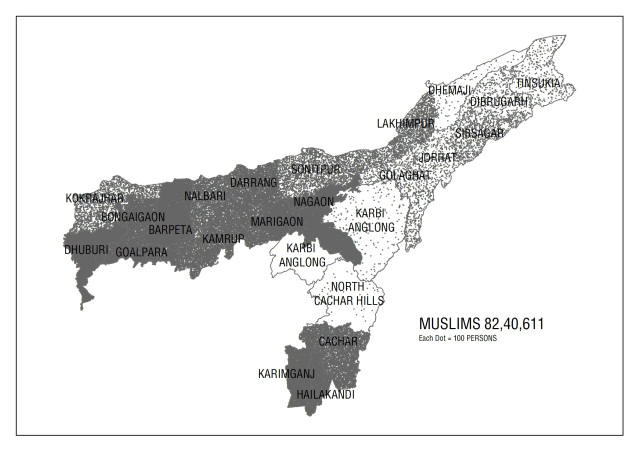
Dialogue January-March, 2011, Volume 12 No. 3
Religious Demography of the Northeastern States of India: Trends to look for in the Census 2011
J.K. Bajaj*
Counting of population for the 2011 census has just been completed. If all goes well, the figures for the current religious profile of the population of India should become available in a couple of years. If the trends of the previous couple of decades continue, we shall see a major change in the religious composition of several parts of India, including and especially the northeast. This is therefore a good time to recall the religious demographic profile of the northeastern sates as recorded in the 2001 census and the trend of change that was observed at that time. Below, we sketch the religious profile of the sever northeastern states – comprising of Assam, Arunachal Pradesh, Nagaland, Manipur, Mizoram, Tripura and Meghalaya – as recorded in 2001 and the changes that were seen then in comparison to the previous census of 1991.
The Northeastern Region
As shown in Table 1, the 2001 census counted a total of 383
lakh people in the seven states of the northeast. Of these, 219 lakh were
Hindus, 89 lakh Muslims and 62 lakh Christians.
There was an accretion of 68 lakh persons to the population
of the region between 1991 and 2001; Hindus acquired 27 lakh persons, Muslims 20
lakh and Christians 19 lakh. The decadal growth of Hindus was thus just about 14
percent, as compared to 30 percent of the Muslims and 45 percent of the
Christians. People belonging to tribal religions grew by almost the same rate as
Hindus, while Buddhists recorded much lower growth.
Table 1: NORTHEAST
2001 1991 Accretion Growth
Total 383 315 68 21.5
Hindus 219 192 27 13.9
Muslims 89 68 20 30.1
Christians 62 43 19 44.7
Buddhists 3.7
3.6 0.1 2.6
ORPs 8.7 7.7 1 13.1
Others
0.9 0.8 0.1 14.4
Numbers are in lakhs. Growth in percent. ORPs (Other
Religions and Persuasions) are mainly people following tribal religions. Others
include Sikhs, Jains and RNS (Religion not stated).
As a consequence of this substantially lower growth of
Hindus, as compared to the Muslims and Christians, their proportion in the
population came down from 61 percent in 1991 to 57 percent in 2001, registering
a decline of 4 percentage points in a single decade. Proportion of Muslims
correspondingly rose from 21.6 to 23.1 percent and that of Christians from 13.7
to 16.2 percent. The decline in the proportion of Hindus and corresponding rise
in that of Muslims and Christians in this region was much sharper than that
observed during the earlier decade of 1981-1991; there are reasons to believe
that this trend of growing differential between the Hindus and others shall get
further emphasized during 2001-2011.
These are figures for all seven of the northeastern states
together. The trends are much sharper in some of the individual states and in
certain districts within those states. It is therefore instructive to look at
the seven states separately.
Assam
Assam is the most populous state of the northeast. Of the
total population of 383 lakh counted in the seven states of the region in 2001,
267 lakh was in Assam alone. Of these 173 lakhs were Hindus, 82 lakh Muslims and
10 lakh Christians.
What is especially noteworthy is however the change in the
population that occurred between 1991 and 2001. There was an accretion of 42
lakh persons in the population during that decade. This was divided almost
equally between Hindus and others. Population of Hindus increased by 22 lakh
persons, that of Muslims by 19 lakh persons and of Christians by more than 2
lakh persons. There was a decline of 1 lakh persons in the followers of tribal
religions. Hindus and tribal religionists together grew by 21 lakh persons, and
Muslims and Christians together added about the same 21 lakh persons, though
their population in 1991 was less than half that of Hindus. This was reflected
in vast differences in the growth rates; decadal growth of Hindus was about 15
percent, that of Muslims and Christians around 30 percent or more.
Table 2: ASSAM
2001 1991 Accretion Growth
Total 267 224 42 18.9
Hindus 173 150 22 14.9
Muslims 82 64 19 29.3
Christians 9.9 7.4 2.4 32.5
Buddhists 0.5 0.6 -0.1
-20.3
ORPs 0.2 1.4 -1.2 -83.4
Others 0.6 0.5 0.11 22.5
Numbers are in lakh. Growth in percent.
Most of the Muslims in the northeastern region are in Assam.
Of 89 lakh Muslims in the region, 82 lakh are in this state. Within Assam, they
are particularly concentrated in some of the districts. As may be seen in the
Map alongside, Muslims have a considerable presence in most of the districts of
lower Assam and in the Cachar region. In 2001, they formed a majority of the
population of Dhubri, Goalpara, Barpeta and Nagaon; and in Karimganj and
Hailakandi of Cachar. In 2011, several other districts of lower Assam are likely
to turn Muslim majority.

A disturbing observation of the count of 2001 was that decadal growth of Hindus in several districts of lower Assam, especially in Bongaigaon, Dhubri, Kokrajhar, Barpeta, Nalbari and Darrang was unnaturally low, indicating the possibility of Hindus leaving the area. Talukwise data shows that in at least 8 taluks of Dhubri, Kokrajhar and Bongaigaon, the number of Hindus counted in 2001 was in fact lower than their number in 1991.
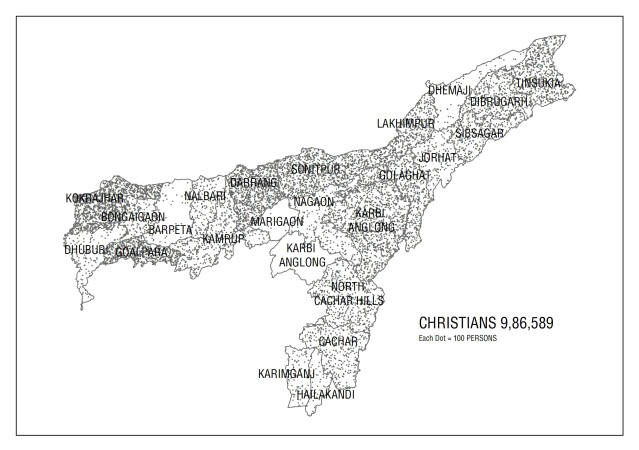
Another remarkable aspect of the 2001 census was the increased presence of Christians in several districts of lower Assam, especially Kokrajhar. This trend needs to be watched. In the Map alongside, we show the distribution of 10 lakh Christians in the state.
Arunachal Pradesh
Arunachal Pradesh has undergone rapid religious demographic
change since 1971, when there were less than 4 thousand Christians in the whole
state in a total population of nearly 5 lakh. In 2001, total population of the
state was 11 lakh, and there were 2 lakh Christians among them.
Table 3: ARUNACHAL PRADESH
2001 1991 Accretion Growth
Total 11.0 8.6 2.3 27.0
Hindus 3.8 3.2 0.6 18.7
Muslims 0.21 0.12 0.1 73.4
Christians 2.1 0.9 1.2 130.9
Buddhists 1.4 1.1 0.3 28.4
ORPs 3.4 3.1 0.2 7.8
Others 0.1 0.2 -0.08 -39.8
Numbers are in lakhs. Growth in percent.
As seen in the Map, Christians in the state up to 2001 were concentrated in a few districts, especially in Tirap, adjoining Nagaland; the district had a quarter of all Christians in the state and was already a Christian majority state in 2001. Changlang and Lohit, adjoining Tirap, had another about 30 thousand Christians. The other region of Christian concentration was Papum Pare, Lower Subansri and East Kameng, which together had 75 thousand of the 2 lakh Christians in the state. There were also about 35 thousand Christians in West Siang and East Siang. If the trends of the last three decades continue, the 2011 census is likely to show a considerably higher presence of Christians in Arunachal Pradesh, and especially in the districts that we have mentioned.
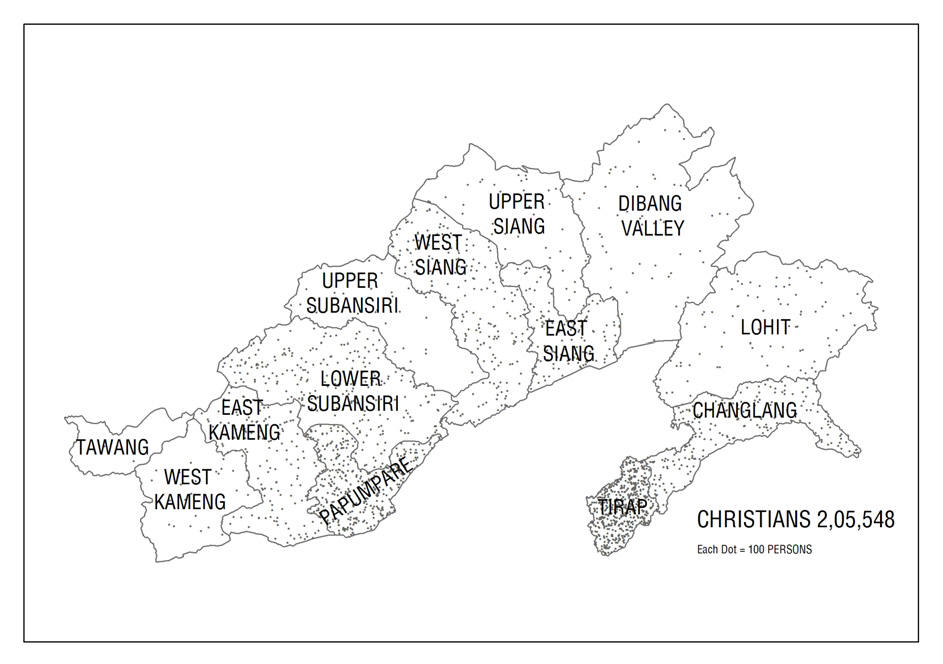
Nearly one-third of the population of Arunachal Pradesh in
2001 was counted as following tribal religions (listed as ORPs in the Table).
The relatively low decadal growth in their numbers seems to indicate that a
considerable part of the conversion to Christianity is taking place from amongst
their ranks. It shall be of interest to watch the changes in their numbers and
proportion in the 2011 census.
There were also 1.4 lakh Buddhists in the state in 2001. They
were particularly concentrated in the western districts of Tawang and West
Kameng and in the eastern districts of Changlang and Lohit. Relatively robust
growth of 28 percent in their numbers between 1991 and 2001 indicates that they
are probably not particularly affected by the growth of Christianity. It shall
be of interest to know whether they have been able to retain their normal growth
during 2001-2011, and resisted the ongoing wave of Christian expansion.
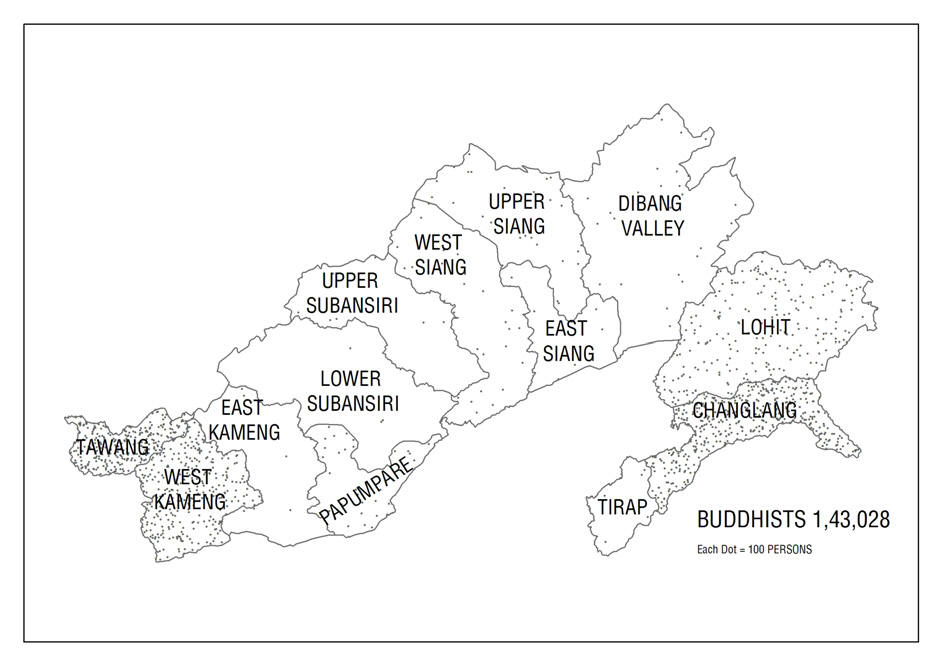
Nagaland
The most significant observation of the 2001 census was the
rather high growth of nearly 65 percent in the total population of Nagaland. It
shall be interesting to know whether the growth momentum would be maintained
during 2001-2011. Nagaland is almost entirely Christian. Of about 1.5 lakh
Hindus in the state, 92 thousand are in Dimapur and another 22 thousand in
Kohima. Nearly 28 thousand of 35 thousand Muslims are also in these two
districts. But, the growth of nearly 70 percent in their numbers between 1991
and 2001 is remarkable; and, it would be of interest to know how their numbers
have grown during 2001-2011.
Table 4: NAGALAND
2001 1991 Accretion Growth
Total 19.9 12.1 7.8 64.5
Hindus 1.53 1.22 0.31 25.1
Muslims 0.35 0.21 0.14 69.6
Christians 17.9 10.6 7.3 69.2
Others 0.12 0.09 0.03 36.5
Numbers are in lakhs. Growth in percent.
Manipur
During the 2001 census, 3 divisions of Senapati district
could not be counted. We have estimated numbers for these divisions by assuming
that the religious demography of the district remained the same as in 1991.
Table 5: MANIPUR
2001 1991
Accretion Growth
Total 22.94 18.37 4.6 24.9
Hindus 10.05 10.59 -0.55 -5.2
Muslims 1.91 1.34 0.57 43.1
Christians 8.56 6.27 2.3 36.6
ORPs 2.36 0.14 2.22 1,578
Others 0.06 0.03 0.03 79
Numbers are in lakhs. Growth in percent.
The most striking aspect of the 2001 census data for Manipur
was the decline in the number of Hindus in the state. This happened because as
many as 2.36 lakh persons were counted under Other Religions and Persuasions,
compared to only about 14 thousand in 1991. As many as 2.22 lakh persons of
Manipur, who had been previously counted as Hindus, gave their religion as "Sanamahi"
during the 2001 census.
Hindus and also the "Sanmahis" are almost all located in the
valley districts of Imphal, Thoubal and Bishnupur, and to a much lesser extent
in Senapati. There are hardly any Hindus or ORPs in the other hill districts, in
all of which Christians form more than 90 percent of the population.
It shall be interesting to see how this phenomenon of Hindus
of Manipur valley registering as "Sanamahis" or under some other belief or
persuasion manifests in the 2011 census.
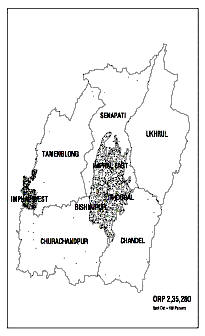
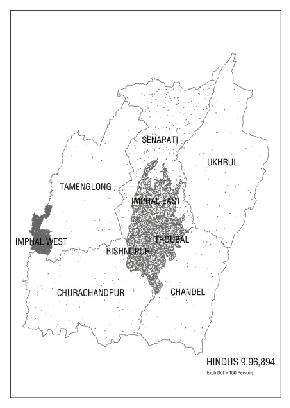
Mizoram
Mizoram has become largely Christian, except for the presence
of about 70 thousand Buddhists in three districts of the state. Of the total
population of 8.89 lakhs counted in 2001, there were 7.73 lakh Christians and
0.70 lakh Buddhists. As seen in the Map here, Buddhists are concentrated largely
in Lawangtlai and Lunglei, and to a lesser extent in Mamit. Besides theses,
there were only about 32 thousand Hindus and 10 thousand Muslims; a large
proportion of both Hindus and Muslims was in Aizwal.
Table 6: MIZORAM
2001 1991 Accretion Growth
Total 8.89 6.90 1.99 28.8
Hindus 0.32 0.35 -0.03 -9.3
Muslims 0.10 0.05 0.06 122.5
Christians 7.73 5.91 1.81 30.7
Buddhists 0.70 0.54 0.16 30
Others 0.04 0.05 -0.01 -29
Numbers are in lakhs. Growth in percent.
Near doubling of the population of Muslims between 1991 and
2001 was another significant feature of the count of 2001. The number of Hindus
on the other hand had in fact declined by about 10 percent during 1991-2001.
Since Mizoram has become largely Christian, not much is
likely to change in the religious demography of the state in 2011. But, it shall
be of interest to know whether the sharp rise in the Muslim population seen in
2001 is replicated in 2011; and, whether the already small number of Hindus
continues to decline further.
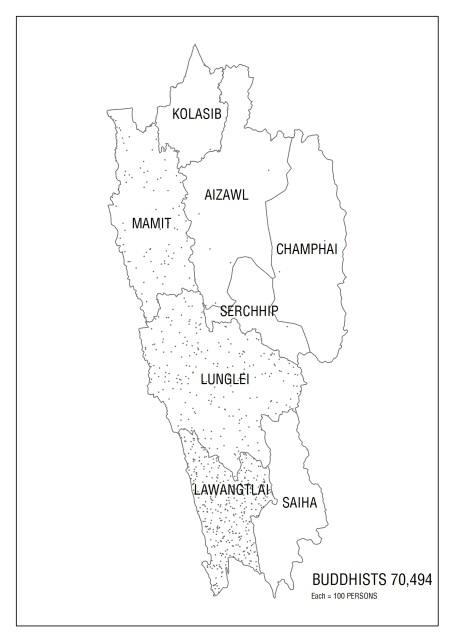
Tripura
The population of Tripura remains largely Hindu; though, as
seen in the Table, during 1991-2001, Christians registered a growth of 120
percent, and even Muslims grew at a rate that was double that of the Hindus.
During that decade, the population of Buddhists declined by about a quarter,
from 1.28 lakh in 1991 to less than a lakh in 2001.
Table 7: TRIPURA
2001 1991 Accretion Growth
Total 31.99 27.57 4.42 16.0
Hindus 27.39 23.85 3.54 14.9
Muslims 2.54 1.96 0.58 29.5
Christians 1.02 0.46 0.56 120.5
Buddhists 0.99 1.28 -0.29 -22.9
Others 0.04 0.01 0.03 287
Numbers are in lakh. Growth in percent.
The religious demography of Tripura is unlikely to change
very drastically during the current decade of 2001-2011. But, it shall be of
interest to see whether the substantial increase in the number of Christians and
a somewhat lesser rise in that of Muslims seen in 2001 becomes a long term
phenomenon. Similarly, the 2011 census will also provide information on whether
the decline in the number of Buddhists during 1991-2001 was an unusual
phenomenon or it marks a new trend.
Meghalaya
Meghalaya has not been Christianised as rapidly or as
completely as Nagaland, Mizoram and the hill districts of Manipur. But the
proportion of Christians there has been increasing substantially from decade to
decade. During 1991-2001, their proportion went up by nearly 6 percentage
points, from 64.6 percent in 1991 to 70.3 percent in 2001. As seen in the Table
alongside, of the total accretion of 5.44 lakh in the population of the state,
4.83 lakh was toward that of Christians. Hindus added about 48 thousand to their
population of 2.6 lakhs. The state also has considerable population of ORPs;
their numbers, however, have declined from 2.98 lakh to 2.67 lakh. This
phenomenon is similar to Arunachal Pradesh, where the growth of Christianity has
led to relative, though not absolute, decline in the presence of ORPs.
Muslims in the state grew by more than 60 percent during
1991-2001; with their population increasing from 61 thousand to 99 thousand. As
we have seen, such unusual increase in the population of Muslims happened in
almost every state of the northeast during 1991-2001. It shall be of great
interest to see whether the trend is sustained in 2011.
Table 8: MEGHALAYA
2001 1991 Accretion Growth
Total 23.19 17.75 5.44 30.7
Hindus 3.08 2.60 0.48 18.3
Muslims 0.99 0.61 0.38 61.4
Christians 16.29 11.46 4.83 42.1
ORPs 2.67 2.98 -0.31 -10.5
Others 0.16 0.08 0.07 84.6
Numbers are in lakhs. Growth in percent.
The most significant part of the religious demography of
Meghalaya is the geographical distribution of the non-Christian, especially
Hindu, population in the state. Most of the Hindus in the state are in the West
Garo Hills and East Khasi Hills districts, where they form nearly one-third of
the population; there are also significant numbers of Hindus in Ribohi, where
they form 20 percent of the population. The substantial population of ORPs in
the state, amounting to 2.67 lakh persons is also largely concentrated in West
Garo and East Khasi Hills, and also in Jaintia Hills. Muslims are also located
mostly in West Garo and East Khasi Hills. Thus much of the non-Christian
population of the state is in the districts of West Garo and East Khasi Hills,
and to a lesser extent in Ribohi and Jaintia. In the central portion of East and
South Garo Hills and in West Khasi Hills, Christians form nearly 90 percent or
more of the population.
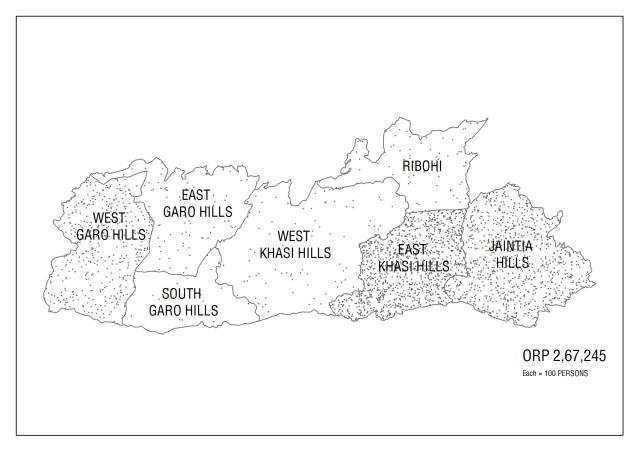
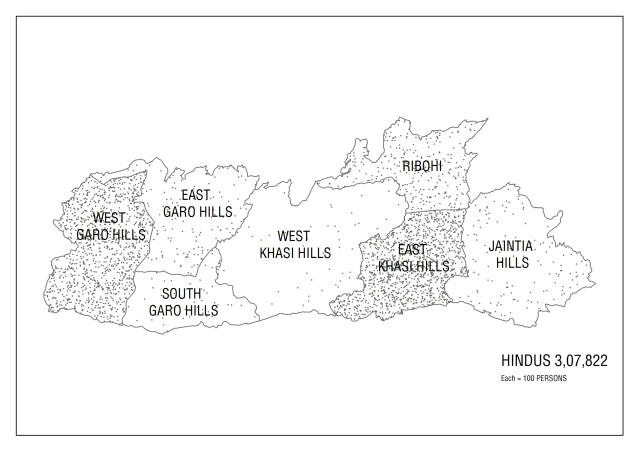
Of 2.67 lakh counted as ORPs, about 2 lakhs are Khasis and 50
thousand Garos. These two are the largest groups of tribes in the state, and a
large majority of them have converted to Christianity. But, in some of the
districts that we have mentioned, they continue to subscribe to their tribal
religions. Only a few among them, however, count themselves as Hindus.
There are smaller groups of tribes, such as Rabas, Hajongs
and Kochs, with populations of 20 to 30 thousand each, and some of even smaller
tribes like the Boro Kacharis, who have remained largely Hindus. The continued
adherence of smaller tribes and some groups within the larger Garo and Khasi
tribes in some of the districts to Hinduism or their tribal religions often
leads to severe ethnic tensions in Meghalaya. Thus there are about 10,000 Rabas
in East Garo Hills, who continue to be counted as Hindus in a district which is
90 percent Christian and where nearly the whole population of the dominant Garo
tribe is Christian. Recently, the district, along with neighbouring Goalpara of
Assam, witnessed major Garo-Raba clashes.
In this context, detailed district and tribe wise figures of
2011 for Meghalaya would be of great interest for both administrators and social
workers alike.
Northeastern States excluding Assam
Before closing, it is instructive to look at the northeastern
states excluding Assam as a group. While Assam has been witnessing growth of
mainly Muslim population, the other states have seen mainly a spurt in
Christianity. Though, as we have seen above, there is considerable increase in
Christian presence in Assam and of Muslim presence in the other six states,
especially in the recent decades.
Table 9: Northeast excluding Assam
2001 1991 Accretion Growth
Total 117.88 91.33 26.56 29.1
Hindus 46.17 41.82 4.34 10.4
Muslims 6.10 4.29 1.82 42.4
Christians 53.56 35.58 17.99 50.6
ORPs 8.50 6.33 2.17 34.3
Buddhists 3.21 2.98 0.23 7.6
Others 0.34 0.33 0.01 3.1
Numbers are in lakhs. Growth in percent.
As seen in Table 9, total population of these states grew by
about 29 percent between 1991 and 2001. Population of Christian grew by 50
percent, that of Muslim by 42 percent and of ORPs by 34 percent, while Hindus
grew by just 10 percent and Buddhists by around 8 percent. Hindus and Buddhists
during the decade, as in the previous decades, suffered loss in their share of
population. The proportion of Christians in the total population thus went up
from less than 39 percent in 1991 to more than 45 percent in 2001. The region is
likely to see a similar or higher rise in the proportion of Christians in 2011.
Conclusion
The northeastern states of India have witnessed great changes
in their religious demography during the last few decades. In the process, large
parts of Assam have turned predominantly Muslim and Nagland, Mizoram and the
whole of Manipur except the valley districts have become predominantly
Christian. In these areas, the changes are almost complete and the only issue of
interest is whether the remnants of Hindus in these areas would continue to stay
there or will their already negligible presence decline further. The issue is
not yet fully settled in Arunachal Pradesh and to an extent in Meghalaya. For
these two states, the figures of 2011 census shall indicate whether the process
of change there is also going to be as complete as it has been elsewhere. The
trends of the last few decades have been going in this direction.
Census is a greatly useful source of information about the
society and the changes taking place in it. We are fortunate to have systematic
census data for nearly 140 years. It is important to keep appreciating and
analyzing this information to know the momentous changes that are taking place
in the religious demography of some parts of India. Knowing in detail about what
is happening may at some stage help us in finding the way out.
Acknowledgement: I acknowledge the help of my young
colleague, Sri Amit Bansal, in preparing the GIS maps of the religious
demography of these states.